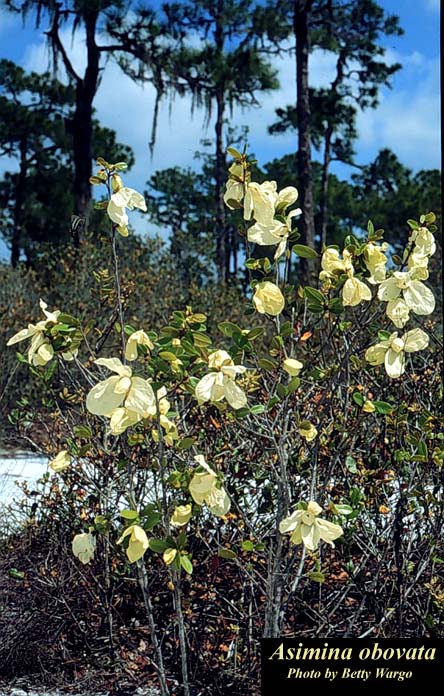Asimina obovata
| Asimina obovata | |
|---|---|

| |
| Photo by Betty Wargo, Atlas of Florida Vascular Plants | |
| Scientific classification | |
| Kingdom: | Plantae |
| Division: | Magnoliophyta - Flowering plants |
| Class: | Magnoliopsida - Dicotyledons |
| Order: | Magnoliales |
| Family: | Annonaceae |
| Genus: | Asimina |
| Species: | A. obovata |
| Binomial name | |
| Asimina obovata (Willd.) Nash | |

| |
| Natural range of Asimina obovata from USDA NRCS Plants Database. | |
Common name: Bigflower pawpaw
Contents
Taxonomic notes
Synonym: Pityothamnus obovatus (Willdenow) Small.[1]
Varieties: none.[1]
Description
A description of Asimina obovata is provided in The Flora of North America.
Asimina obovata is a long-lived perennial.[2] Such as other species in the Genus Asimina, it has a deep taproot and resprouts from a lignotuber after fire or disturbance[3] (Kral 1993). Leaves are alternate and simple with pinnate venation.[4] It can be a shrub or a small tree growing three meters or more.[5]
Asimina obovata does not have specialized underground storage units apart from its taproot.[6] Diaz-Toribio and Putz (2021) recorded this species to have an non-structural carbohydrate concentration of 72 mg/g (ranking 61 out of 100 species studied).[6]
Distribution
Ecology
Habitat
Asimina obovata is endemic to the well drained sand of sand ridges, coastal dunes, hammocks and pine-turkey oak sand ridges that occur in southeastern to north central Florida.[3] Associated species include Pinus clausa, Quercus gemiata, Quercus myrtifolia, Ceratiola ericoides, Ilex opaca var. arenicola, Garberia heterophylla, and Persea humilus.[7]
Phenology
Flowers March to June[3] with white flowers and green fruit.[2]
Asimina obovata is the only species in the genus Asimina to have flower buds that terminate the new shoot growth.[3] This species can be identified by a bright red-hairy peduncle and a reddish pubescence on the shoots and lower leaf surface.[3] The stamens are pale green to beige at anthesis.[8]
Seed bank and germination
Seedlings have been found in the shade of parent plants due to the importance of shade and seed burial to prevent seed desiccation after ripening.[7]
Fire ecology
In the year following a fire, A. obovata resprouts with more stems than were present pre-fire, however these stems are smaller and less woody with a higher chance of herbivory. The amount of flowers blooming is the greatest in the second flowering season post-fire with flower numbers decreasing as the fire interval becomes longer.[8]
The species responds to a disturbance such as fire or cutting vegetatively, sending up several leafy shoots which are forming flower buds that do not open until the following growing season.[3]
Pollination
Pollination occurs entomophily [9] with beetles such as Typocerus zebra, Trichotinus rufobruneus, T. lunulatus and Euphoria sepulchralis responsible for pollination.[10] The following Hymenoptera families and species were observed visiting flowers of Asimina obovata at Archbold Biological Station:[11]
Apidae: Apis mellifera
Vespidae: Polistes dorsalis hunteri
Use by animals
In order to protect itself from herbivory, A. obovata contains a toxin called annonaceous acetogenins which inhibits mitochondrial respiration in preditors.[9]
Gopher tortoises have been observed to eat the ripe fruit and spit out the seeds.[10]
Conservation and management
Global conservation status: G3-Vulnerable.[12] State status: S3-Vulnerable.[12]
Cultivation and restoration
Photo Gallery
References and notes
- ↑ 1.0 1.1 Weakley, A.S. 2015. Flora of the southern and mid-atlantic states. Working Draft of 21 May 2015. University of North Carolina at Chapel Hill, Chapel Hill, North Carolina.
- ↑ 2.0 2.1 [Florida Native Plant Society. Accessed: November 24, 2015]
- ↑ 3.0 3.1 3.2 3.3 3.4 3.5 Kral, Robert. 1960. A Revision of Asimina and Deeringothamnus (Annonaceae). Brittonia 12:233-278.
- ↑ [Lady Bird Johnson Wildflower Center. Accessed: November 23, 2015.]
- ↑ [[1]]Accessed: November 24, 2015.
- ↑ 6.0 6.1 Diaz-Toribio, M.H. and F. E. Putz 2021. Underground carbohydrate stores and storage organs in fire-maintained longleaf pine savannas in Florida, USA. American Journal of Botany 108: 432-442.
- ↑ 7.0 7.1 Crummer, Kathryn. Physiological Leaf Traits of Scrub Pawpaw, Asimina obovata (Willd.)Nash (Annonaceae). University of Florida, 2003.
- ↑ 8.0 8.1 [[2]] Archbold Biological Station. Accessed: November 24, 2015
- ↑ 9.0 9.1 [Encyclopedia of Life]Accessed November 24, 2015
- ↑ 10.0 10.1 Norman, Elaine M. and David Clayton. Reproductive Biology of Two Florida Pawpaws: Asimina obovata and A. pygmaea (Annonaceae). 1986. Bulletin of the Torrey Botanical Club 113: 16-22.
- ↑ Deyrup, M.A. 2015. Database of observations of Hymenoptera visitations to flowers of plants on Archbold Biological Station, Florida, USA.
- ↑ 12.0 12.1 [[3]] Nature Serve Explorer. Accessed November 24, 2015.]]